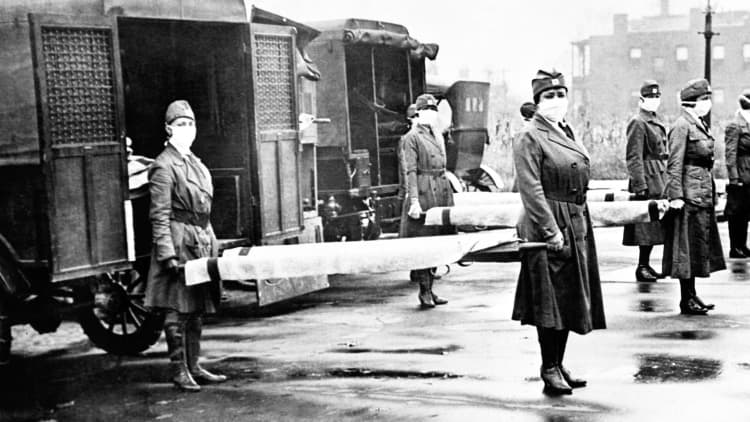In less than nine months, the coronavirus has quickly spread to more than 33 million people across the globe, killing more than 1 million and becoming the third-leading cause of death in the United States, behind only heart disease and cancer.
There is nothing in recent history that compares to a contagious crisis of this magnitude, according to historians who study infectious diseases and disasters. The H1N1 flu pandemic in 2009 infected an estimated 60.8 million people in its first year, but the virus wasn't nearly as severe as Covid-19, killing between 151,700 and 575,400 worldwide, according to the Centers for Disease Control and Prevention. MERS, another coronavirus that emerged in 2012, was much deadlier than Covid but significantly less infectious with only 2,494 reported cases.
Covid-19 is "a scary virus and definitely one that you do not want to get," said Howard Markel, a physician and medical historian at the University of Michigan. "It's a very dangerous, very crafty, stealthy virus."
The 1918 virus was also a "novel" virus, meaning it was brand new. Like Covid-19, no one had any immunity to it, and it was highly infectious, spreading through respiratory droplets that pass when an infected person coughed or sneezed.
Different symptoms
The viruses attacked the body in different ways. Covid-19 can be mild, sometimes causing no symptoms whatsoever, or severe — putting patients in hospitals and on ventilators for weeks and leaving them with lingering effects of fatigue and coughing for months. Covid-19 can also be unpredictable, stressing virtually every system in the body, including the heart, kidneys and brain.
The 1918 flu pandemic came in three waves, occurring in the spring of 1918, the fall of 1918; and the winter and spring of 1919, according to the CDC.
The 1918 flu killed 50 million people worldwide from 1918 through 1919, including 675,000 Americans, according to the CDC. It is estimated that one-third of the world's population became infected with the virus.
The first wave of the 1918 flu came with the usual flu symptoms: fever, nausea, body aches and diarrhea. The second wave was dramatically worse. It could set in suddenly, killing patients within days or even hours after symptoms began. The virus would cause their lungs to fill with fluid and the lack of oxygen would make their skin turn blue until they suffocated.
There also wasn't a vaccine for the 1918 flu, and, like Covid-19, the crisis was highly politicized in the United States.

"We were getting involved in World War I and it was a very patriotic effort. You know, the war to end all wars," Markel said. "They were sending off young men in parades. Women were left behind and starting Red Cross chapters and making bandages and all sorts of things, sending the men off in a proper way."
The pandemic became mixed in with the patriotic fervor, he said.
Like today, schools and businesses were closed and infected people were quarantined, according to influenzaarchive.org.
1918 mask mandates
"You told people to wash your hands, don't cough on people, stay at home, stay away from other people," he said. "It was the patriotic thing to do to not cough on people or stay home if you were sick."
But the thing that really drew public backlash were mask recommendations. As it turns out, resistance to wearing the face coverings isn't new. People during the 1918 pandemic called them dirt traps and some clipped holes so they could smoke cigars.
In Europe, the Italian Supreme Command asked residents not to fail their cities by not wearing a mask. Several U.S. cities implemented mandates, describing them as a symbol of "wartime patriotism." In San Francisco, Mayor James Rolph said, "conscience, patriotism and self-protection demand immediate and rigid compliance," according to influenzaarchive.org. But some people refused to comply or take them seriously, Markel said.
San Francisco residents considered masks a nuisance while others harbored resentment for being forced to wear them, he said. Some of them were arrested.
"One woman, a downtown attorney, argued to Mayor Rolph that the mask ordinance was 'absolutely unconstitutional' because it was not legally enacted, and that as a result, every police officer who had arrested a mask scofflaw was personally liable," according to influenzaarchive.org.
Pandemic news
The news in 1918 didn't flow as quickly as it does today with the internet and smartphones, but it also couldn't be manipulated as much as today and newspapers published at least six or seven editions a day back then, Markel said. State public health departments also held regular public press briefings, he added.
"If you wanted to partake on it, it was there," he said.
Some newspapers referred to the virus as the "Spanish flu," even though the first known case was reported at an army base in Kansas. Spain remained neutral throughout World War I and reported on the virus freely, giving the impression that the outbreak was bad there. Eventually, newspapers would just refer to it as "influenza" or the "influenza epidemic," Markel said.
Woodrow Wilson vs Donald Trump
Additionally, some reports have suggested that then-President Woodrow Wilson downplayed the virus, but that is a "wrong and a false trope of popular history," Markel said. Wilson, who would later contract the virus, was organizing and commanding the U.S. effort in World War I and once the war ended, he sailed for Paris, where he stayed until April of 1919 organizing a peace treaty and the League of Nations, Markel said.
"The federal government played a very small role in American public health during that era. It was primarily a city and state role and those agencies were hardly downplaying it," he said.
Unlike today, there was no CDC or national public health department. The Food and Drug Administration existed but consisted of a very small group of men. Additionally, there were no antibiotics, intensive care units, ventilators, IV fluids or vaccines. "You got a bed or maybe nursing care," Markel said.
But there was an epidemiologist much like Dr. Anthony Fauci, director of the National Institute of Allergy and Infectious Diseases, who withstood criticism for publicly pressing for safety protocols, according to Forbes.
"At the center of public health efforts in both states was a practical, plainspoken, bespectacled scientist: Dr. Thomas Dyer Tuttle, who became a powerful, if polarizing, figure in the fight against the Spanish flu," according to Forbes.
Scientists hadn't even seen a virus under the microscope at that point, said Graham Mooney, a medical historian at Johns Hopkins University School of Medicine. They didn't have the technology and they knew almost nothing of virology, which was considered a nascent science because viruses are so small, he said. In fact, some scientists thought the 1918 virus was caused by a bacteria called Haemophilus influenzae, he said.
"Now we have a much greater capacity to create a preventative mechanism through immunizations and vaccinations," Mooney said.
Massive death toll
The 1918 virus also tended to kill differently than Covid-19, Mooney and Markel noted. With World War I, there was a massive movement of men across all of America and Europe. While the coronavirus can be especially severe for the elderly and those with underlying health conditions, the 1918 virus was unusual in that it killed many young adults, Markel said.
"Influenza generally has a U shaped mortality curve, meaning it looks like a U, but the tops of the U are the most deadly," Markel said. "But in 1918 it was a W shaped mortality curve and that upside-down part of the W, the V, was young people between ages 18 and 40 dying like flies. That was odd. That was not typical for previous flu pandemics or subsequent ones."
It's also important to consider population when talking about outbreaks or disasters, said Samantha Montano of the Massachusetts Maritime Academy, who studies disasters. In 1918, the world population was much smaller with an estimated 1.8 billion people. Today, there are nearly 8 billion on the planet.
Mooney echoed those remarks, saying, "We're talking about a global population that is sort of smaller than it is now." He said the death toll from 1918 virus likely had a great impact on the workforce who were unable to work from home or remotely like we can today.
"You end up having major structural, economic and social readjustments when you have such a massive death toll like that," he said. "We have social welfare networks ... people travel around the globe. We have different societies and economies."
Medical historians say the U.S. can learn from the 1918 virus.
"It is utterly earth-shaking what we've done in the last century alone," Markel said.



